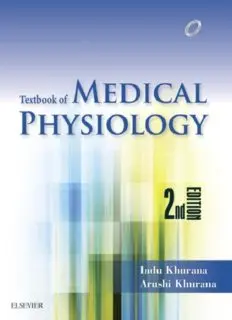
Textbook of Medical Physiology PDF
Preview Textbook of Medical Physiology
Textbook of Medical Physiology SECOND EDITION Indu Khurana, MD Senior Professor, Department of Physiology, Postgraduate Institute of Medical Sciences, Rohtak, India Arushi Khurana, MD Chief Medical Resident, University of Connecticut, School of Medicine, Hartford, Connecticut, USA 2 Table of Contents Cover image Title page Copyright Dedication Preface Part I. General Physiology Section 1. General Physiology Introduction 1.1. Functional organization, composition and internal environment of human body Functional organization of the human body Body composition Internal environment and homeostasis 1.2. The cell physiology Cell structure 3 The cell membrane Intercellular junctions 1.3. Transport through cell membrane Passive transport Active transport Vesicular transport Other transport processes 1.4. Membrane potential Introduction Genesis of membrane potential Recording of membrane potential 1.5. Genetics: An overview Structural and functional characteristics of substrate for genetics Applied genetics Part II. Systemic Physiology Section 2. Nerve Muscle Physiology Introduction 2.1. The nerve Functional anatomy Biological activities Electrical properties of nerve fibre Physiological properties of nerve fibres 4 Nerve fibre types Degeneration and regeneration of neurons Factors promoting neuronal growth 2.2. Neuromuscular junction Structure of neuromuscular junction Neuromuscular transmission Drugs affecting and disorders of neuromuscular junction 2.3. Skeletal muscle Introduction Functional anatomy and organization Process of muscle excitability and contractility Characteristics of muscle excitability and contractility Some characteristics of the skeletal muscles in the intact body Electromyography and common disorders of muscles Source of energy and metabolic phenomenon during muscle contraction 2.4. Smooth muscle and cardiac muscle Smooth muscle Cardiac muscle Comparison of skeletal, smooth and cardiac muscles Section 3. Blood and Immune System Introduction Functions of blood 5 Immune system 3.1. Plasma and plasma proteins Plasma Plasma proteins 3.2. Red blood cells and anaemias Characteristic features of red blood cells Formation of red blood cells Haemoglobin Red cell fragility Lifespan and fate of red blood cells Bilirubin and jaundice Anaemias 3.3. White blood cells White blood cells types and their counts Formation of white blood cells Morphology, functions, lifespan and variations in counts of WBCs Applied aspects 3.4. Immune mechanisms Introduction Architecture (components) of immune system Immunity Antigens Antibodies 6 Development of immune response Other immune mechanism-related aspects 3.5. Platelets, haemostasis and blood coagulation Platelets Haemostasis Blood coagulation Clotting factors Mechanism of coagulation Antihaemostatic mechanisms Bleeding disorders 3.6. Blood groups and blood transfusion Blood groups Blood transfusion Blood components Section 4. Cardiovascular System Introduction Functions of CVS Physiology of CVS 4.1. Functional anatomy of heart and physiology of cardiac muscle Functional anatomy of heart Physiology of cardiac muscle 4.2. Origin and spread of cardiac impulse and electrocardiography 7 Origin and spread of cardiac impulse Electrocardiography 4.3. Heart as a pump: Cardiac cycle, cardiac output, and venous return Cardiac cycle Cardiac output and venous return 4.4. Dynamics of circulation: Pressure and flow of blood and lymph Introduction Functional organization and structure of vascular system Haemodynamics Pressure and flow in various functional segments of systemic vascular tree Blood pressure 4.5. Cardiovascular regulation Introduction Neural control mechanism Humoral control mechanisms Local control mechanisms 4.6. Regional circulation Introduction Coronary circulation Cerebral circulation Cutaneous circulation Skeletal muscle circulation Splanchnic circulation 8 4.7. Cardiovascular homeostasis in health and disease Cardiovascular homeostasis in health Cardiovascular homeostasis in diseases Section 5. Respiratory System Introduction 5.1. Respiratory tract: Structure and functions Functional anatomy Functions of the respiratory system 5.2. Pulmonary ventilation Introduction Mechanics of pulmonary ventilation Lung volumes and capacities Pulmonary elastance and compliance Work of breathing 5.3. Pulmonary circulation Functional anatomy Characteristic features of pulmonary circulation Functions of pulmonary circulation Regulation of pulmonary blood flow 5.4. Pulmonary diffusion Introduction Physics of gas diffusion and gas partial pressures 9 Alveolar ventilation Alveolar ventilation–perfusion ratio Alveolar air Diffusion of gases through the respiratory membrane 5.5. Transport of gases Introduction Transport of oxygen Transport of carbon dioxide 5.6. Regulation of respiration Introduction Neural regulation of respiration 5.7. Respiration: Applied aspects Introduction Respiratory adjustments to stresses in health Disturbances of respiration Artificial respiration and cardiopulmonary resuscitation Pulmonary function tests Section 6. Excretory System Introduction Functions of excretory organs Overview of excretory system 6.1. Kidneys: Functional anatomy and blood flow 10
